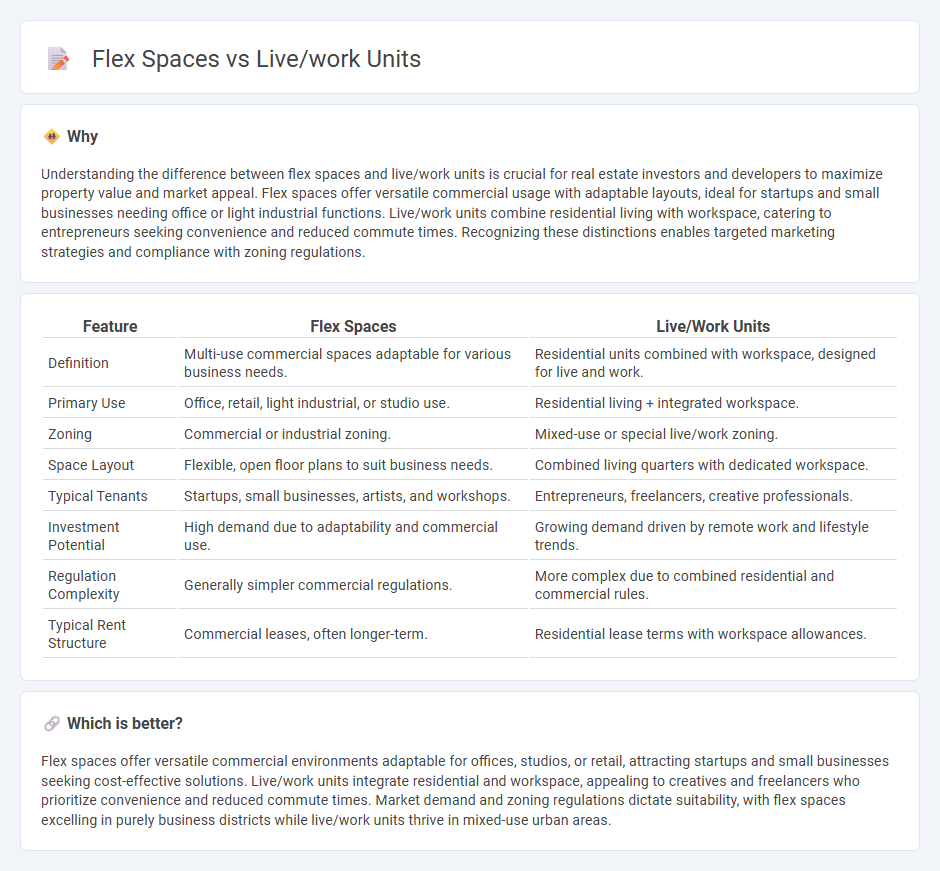
Flex spaces provide adaptable areas designed for multiple uses such as offices, studios, or retail, catering to professionals seeking versatile environments. Live/work units combine residential and commercial functions within the same property, offering convenience for entrepreneurs and creatives who desire an integrated lifestyle. Explore the benefits and differences between flex spaces and live/work units to determine the best fit for your real estate needs.
Why it is important
Understanding the difference between flex spaces and live/work units is crucial for real estate investors and developers to maximize property value and market appeal. Flex spaces offer versatile commercial usage with adaptable layouts, ideal for startups and small businesses needing office or light industrial functions. Live/work units combine residential living with workspace, catering to entrepreneurs seeking convenience and reduced commute times. Recognizing these distinctions enables targeted marketing strategies and compliance with zoning regulations.
Comparison Table
| Feature | Flex Spaces | Live/Work Units |
|---|---|---|
| Definition | Multi-use commercial spaces adaptable for various business needs. | Residential units combined with workspace, designed for live and work. |
| Primary Use | Office, retail, light industrial, or studio use. | Residential living + integrated workspace. |
| Zoning | Commercial or industrial zoning. | Mixed-use or special live/work zoning. |
| Space Layout | Flexible, open floor plans to suit business needs. | Combined living quarters with dedicated workspace. |
| Typical Tenants | Startups, small businesses, artists, and workshops. | Entrepreneurs, freelancers, creative professionals. |
| Investment Potential | High demand due to adaptability and commercial use. | Growing demand driven by remote work and lifestyle trends. |
| Regulation Complexity | Generally simpler commercial regulations. | More complex due to combined residential and commercial rules. |
| Typical Rent Structure | Commercial leases, often longer-term. | Residential lease terms with workspace allowances. |
Which is better?
Flex spaces offer versatile commercial environments adaptable for offices, studios, or retail, attracting startups and small businesses seeking cost-effective solutions. Live/work units integrate residential and workspace, appealing to creatives and freelancers who prioritize convenience and reduced commute times. Market demand and zoning regulations dictate suitability, with flex spaces excelling in purely business districts while live/work units thrive in mixed-use urban areas.
Connection
Flex spaces and live/work units are interconnected by their shared ability to blend residential and commercial uses, catering to the growing demand for hybrid environments in urban real estate. Both concepts optimize space efficiency by providing adaptable layouts that accommodate remote work, creative studios, or small business operations within the same footprint as living quarters. This integration supports a dynamic lifestyle and promotes sustainable urban development by reducing commuting time and fostering community-centric mixed-use neighborhoods.
Key Terms
Zoning
Live/work units and flex spaces differ significantly in zoning classifications, with live/work units typically zoned for residential use with some commercial allowances, while flex spaces are primarily designated for light industrial or commercial purposes. Zoning regulations for live/work units often emphasize mixed-use residential areas to support both living and low-impact business activities, whereas flex spaces are more flexible in accommodating various commercial, storage, or manufacturing functions within industrial or commercial zones. Explore zoning codes and municipal guidelines in detail to understand how they affect the development and use of live/work versus flex space properties.
Mixed-use
Live/work units blend residential and commercial functions within a single space, catering to professionals seeking proximity between home and workspace in mixed-use developments. Flex spaces offer adaptable layouts designed to accommodate evolving business needs, such as offices, retail, or creative studios, enhancing the functionality of mixed-use environments. Explore more about optimizing mixed-use developments with live/work units and flex spaces.
Adaptability
Live/work units offer integrated residential and commercial spaces tailored for entrepreneurs seeking seamless living and working environments, enhancing daily adaptability. Flex spaces provide versatile layouts designed for varied business needs, allowing quick reconfiguration to support evolving operational requirements. Explore the distinctive adaptability features of live/work units and flex spaces to determine the ideal solution for your lifestyle and business objectives.
Source and External Links
The Ten Truths of Live-Work Planning Policy - Discusses the planning implications of live-work spaces, highlighting their flexibility and tendency to revert to residential use.
Live-Work - Missing Middle Housing - Describes live-work units as small to medium-sized structures with a dwelling unit above a flexible ground floor space for non-residential use.
East Commerce Live/Work Lofts - Offers live-work lofts in San Antonio with unique industrial styles and amenities like a dog park and gated parking.
 dowidth.com
dowidth.com